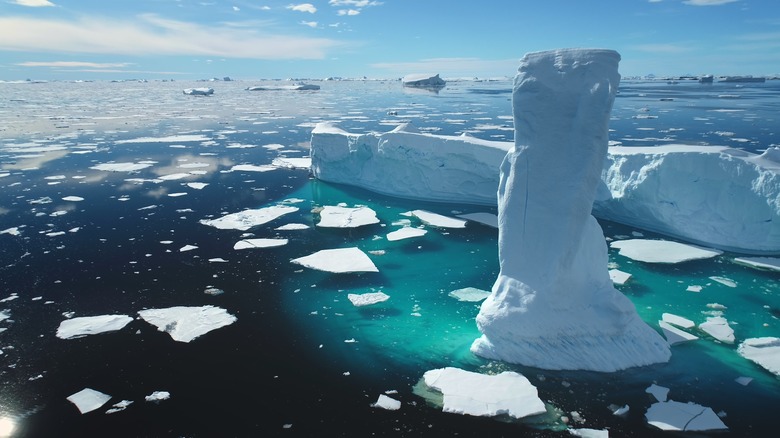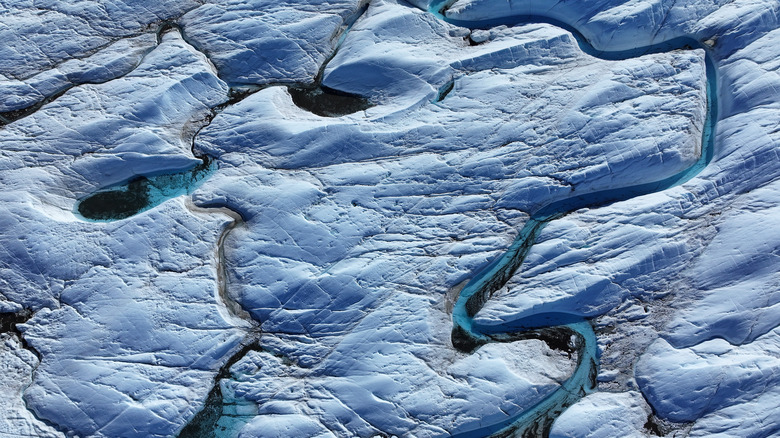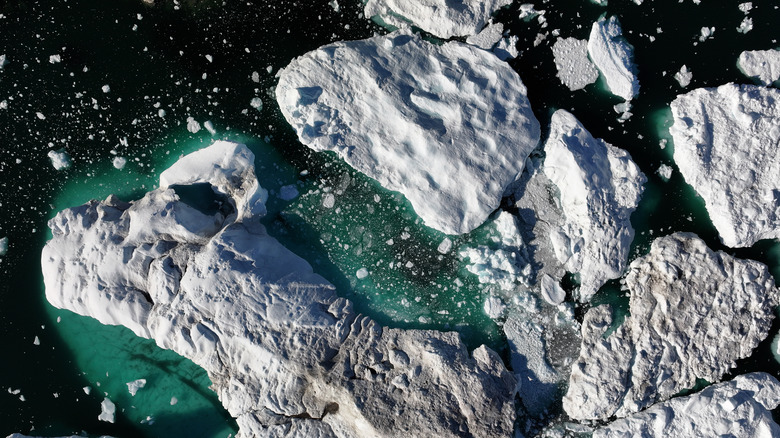The Alarming Reason Researchers Are Seeing Green Beneath The Arctic Ice
In 2011, Stanford University professor Kevin Arrigo and a team of researchers made an unexpected discovery beneath the Arctic ice, publishing their findings with Science: a large bloom of phytoplankton flourishing where it shouldn't have been able to survive. Phytoplankton, microscopic organisms that produce oxygen through photosynthesis, need sunlight to thrive. Due to the thickness and reflectivity of ice in the Arctic, however, scientists had long assumed that it would be impossible for such significant algae blooms to occur there.
The green color of the bloom, a hue not typically seen in the snow white and ice blue palette of the Arctic, alarmed the researchers and ignited a search for an explanation of how it was possible and what it could mean for the region's ecosystem.
Six years later, Christopher Horvat, a then-graduate student at Harvard University, published a research paper in Science Advances that proposed an answer: Global warming had caused the ice to thin enough that it allowed more light to penetrate through its surface. This thinner ice, which not only let a higher degree of light pass through it, also lost its ability to reflect sunlight as effectively. This combination created the right conditions for phytoplankton photosynthesis on a massive scale. The discovery of this phenomenon suggests something potentially paradigm breaking in the scientific community: Climate change isn't just turning Antarctica green, but it's also fundamentally reshaping one of the coldest ecologies on Earth.
The discovery of phytoplankton beneath Arctic ice
There's than just glowing snow in the Arctic, and the discovery of phytoplankton blooms under the Arctic ice was made during a research expedition in the Chukchi Sea, an area of the Arctic Ocean between Siberia and Alaska. In 2011, Kevin Arrigo's team of researchers was in the region studying how life in the ocean was responding to changes in sea ice levels.
Using sensors made to detect how much phytoplankton is in the water, Arrigo noticed an increase in readings as their ship made its way into the ice pack — so much so that it caused him to think the machine was malfunctioning. Far from being a mistake, their instrument had picked up the beginning of an algae bloom that extended for 60 miles into the ice on the Chukchi Sea continental shelf.
Not only had the team discovered the presence of the ice-covered phytoplankton, they also learned that its productivity — phytoplankton biomass multiplied by its growth rate — is potentially 10 times higher than what the organism's Arctic open-sea counterparts are capable of. That number matters, as it just goes to show that climate change can affect life in even the deepest parts of the ocean; phytoplankton is a crucial component of global ecosystems, being responsible for producing up to 50% of the oxygen in the atmosphere and functioning as a critical resource at the base of the oceanic food chain.
Why Arctic phytoplankton has scientists worried
Picking up where Kevin Arrigo's work left off in 2017, Harvard graduate student Christopher Horvat and a team of colleagues proposed that the under-ice phytoplankton blooms were enabled by a thinning in the Arctic ice itself. This, they claimed, allowed light to penetrate deeper and more effectively into the ice surface, spurring the photosynthesis the organisms require to survive.
The culprit behind it all, according to their paper published in Science Advances, is a rise in global temperatures due to climate change. Such a find has given scientists good cause for alarm. The fact that Arctic ice has begun to thin enough for the widespread production of algae blooms points to a dramatic shift in the region's ecology. More sunlight reaching deeper into the ice means that ice melts faster, contributing to another feedback loop involving warm underwater currents. In short, there's more melted ice and light absorbed by the ocean, and the cycle continues.
Those are perfect conditions for organisms like phytoplankton to continue to grow in number, and that could have unpredictable effects on the Arctic ecosystem. While phytoplankton blooms support marine life, such a rapid change could profoundly impact species that rely on the region's predictable ecological systems. As Horvat and colleagues put it in their research paper, "[This result] indicates that climate change has markedly altered the ecological underpinnings of the Arctic Ocean and its carbon cycle."


